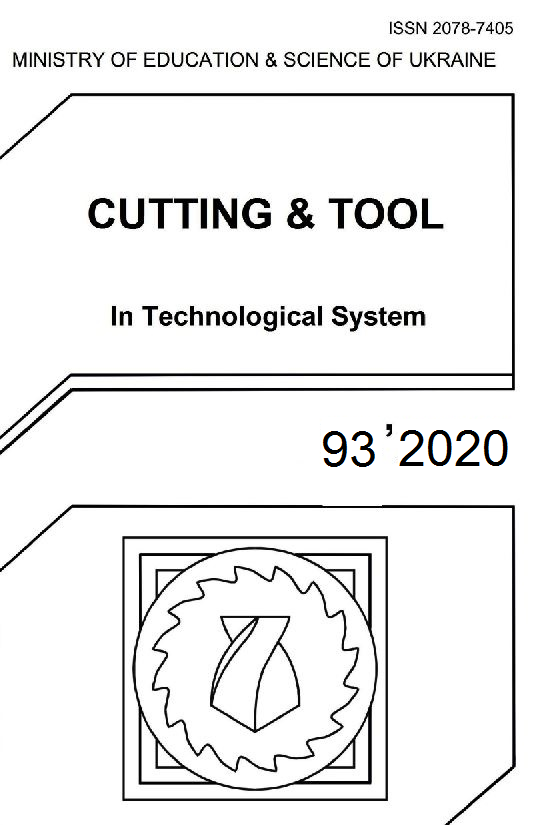INFLUENCE OF MEASUREMENT SETTINGS ON AREAL ROUGHNESS WITH CONFOCAL CHROMATIC SENSOR ON FACE-MILLED SURFACE
DOI:
https://doi.org/10.20998/2078-7405.2020.93.08Keywords:
surface roughness, areal roughness, confocal chromatic sensor.Abstract
Roughness measurement is of highlighted importance in production for describing the quality control of manufacturing processes for the functional, tribological, etc. properties of the surfaces of parts. In the last 15 years or so the areal roughness studied on topographies has also become more common, as it provides a more accurate and detailed characterization of the surfaces. However, with relatively little experience and different technical conditions, topographies are analyzed differently. Sometimes 3D topography is used only as an illustration; however, spatial roughness measurement can provide much more information. The effect of measurement speed and point density during roughness measurement on the areal roughness was investigated using a confocal chromatic sensor.References
I. Zagórski, J. Korpysa: Surface Quality Assessment after Milling AZ91D Magnesium Alloy Using PCD Tool, Materials vol.13(3) (2020) ArtNo:617.
B. Karpuschewski, J. Kundrák,
T. Emmer, D. Borysenko: A New Strategy in Face Milling - Inverse Cutting Technology, Solid State Phenomena vol.261 (2017) pp.331-338.
J. Kundrak, C. Felho: 3D roughness parameters of surfaces face milled by special tools, Manufacturing technology vol.16(3) (2016) pp.532-538.
G. Varga, J. Kundrák: Effects of Technological Parameters on Surface Characteristics in Face Milling, Solid State Phenomena vol.261 (2017) pp.285-292.
Jiang, X., Scott, P. J., Whitehouse, D. J., Blunt, L.: Paradigm shifts in surface metrology. Part I. Historical philosophy, Proceedings of the Royal Society A: Mathematical, Physical and Engineering Sciences vol.463(2085), (2007) pp.2049-2070.
S.K. Fecske, K. Gkagkas, C. Gachot, A. Vernes: Interdependence of Amplitude Roughness Parameters on Rough Gaussian Surfaces, Tribology Letters vol.68(1) (2020) pp.1-15.
K. Klauer, M. Eifler, B. Kirsch, J. Seewig, J.C. Aurich: Ball end micro milling of areal material measures: influence of the tilt angle on the resulting surface topography, Production Engineering vol.14(2) (2020) pp.239-252.
M. Niemczewska-Wójcik, A. Wójcik: The multi-scale analysis of ceramic surface topography created in abrasive machining process, Measurement vol.166 (2020) ArtNo:108217.
S. Wojciechowski, R. Talar, P. Zawadzki, S. Legutko, R. Maruda, C. Prakash: Study on Technological Effects of a Precise Grooving of AlSi13MgCuNi Alloy with a Novel WCCo/PCD (DDCC) Inserts, Materials vol.13(11) (2020) ArtNo:2467.
K Mouralova, L Benes, T Prokes, J Bednar, R. Zahradnicek, J. Fries: Machining of pure molybdenum using WEDM, Measurement vol.163 (2020) ArtNo:108010.
Geometrical product specifications (GPS) — Surface texture: Areal — Part 3: Specification operators. ISO 25178-3:2012. Geneva: International Organization for Standardization.
Downloads
Published
Issue
Section
License
Copyright Notice
Authors who publish with this Collection agree to the following terms:
1. Authors retain copyright and grant the Collection right of first publication with the work simultaneously licensed under a Creative Commons Attribution License that allows others to share the work with an acknowledgement of the work's authorship and initial publication in this Collection.
2. Authors are able to enter into separate, additional contractual arrangements for the non-exclusive distribution of the Collection's published version of the work (e.g., post it to an institutional repository or publish it in a book), with an acknowledgement of its initial publication in this Collection.
3. Authors are permitted and encouraged to post their work online (e.g., in institutional repositories or on their website) prior to and during the submission process, as it can lead to productive exchanges, as well as earlier and greater citation of published work.

